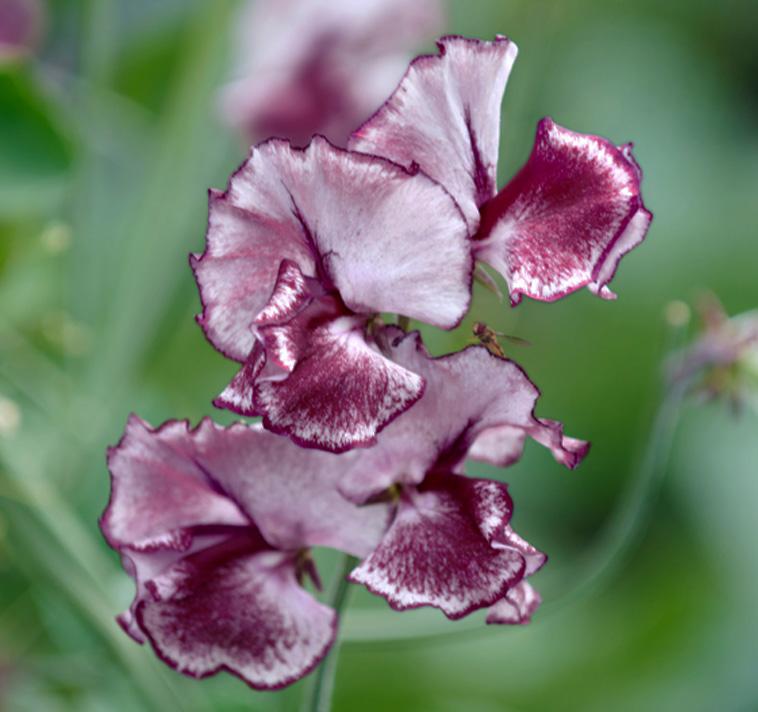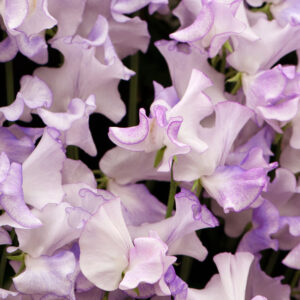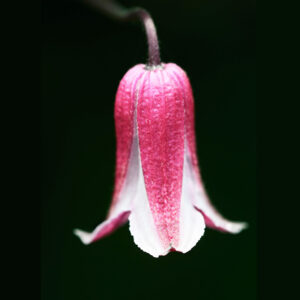- 1-9 pkts $4.50
- 10 pkts FREE
- Express post $12
Lathyrus odoratus ‘Spencer Wiltshire Ripple’
SPENCER WILTSHIRE RIPPLE SWEET PEAS
Lathyrus odoratus ‘Spencer Wiltshire Ripple’ is an outstanding and much loved heritage variety, outstanding even amongst all the gorgeous family of Spencer Sweet Peas.
Unique edges & ripples of claret & chocolate on white ruffled petals
Lathyrus odoratus ‘Spencer Wiltshire Ripple’ is a colour delight, with each white petal edged and rippled with claret and chocolate.
So no two flowers are alike in marking but all are strikingly lovely and lusciously perfumed.
Deliciously honey sweet Sweet Pea scent
The old fashioned Spencer Sweet Peas are known for their intoxicating and irresistible perfume – you just can’t resist burying your nose in them.
And ‘Spencer Wiltshire Ripple’ does not disappoint – with a strong, sweet, overwhelming perfume.
Recently re-discovered heritage variety
Lathyrus odoratus ‘Spencer Wiltshire Ripple’ is an old heritage variety that was thought to be lost and sadly missed. However it has recently been re-discovered and is now back as an all-time favourite.
A winner for florists with ruffled & frilled flowers on long stems
The petal edges are also ruffled and frilled, a charming characteristic of the noble Spencer strain of Sweet peas.
Fortunately ‘Spencer Wiltshire Ripple’ also has exceptionally long stems, making them ideal for picking, and usually five to seven especially large showy flowers per stem.
So it is a winner for florists, in a vase or on the show bench, as well as in the garden.
Wonderful florists flowers for perfume & colour
So ‘Spencer Wiltshire Ripple’ provides lovely blooms for vases and bouquets, and a small bunch can sweetly scent the whole room.
Little wonder that this unusual, re-discovered heritage variety has rapidly become a darling of the floristry trade.
Tips for florists picking ‘Spencer Wiltshire Ripple’
- Pick the stems early in the day and before the flowers are fully open.
The perfect day to pick is when the lowest blossom on the stem has just started to open. - Singe the base of the stems with a match or candle, or dip the stem ends in boiling water for a few minutes.
- Plunge the stems in a vase of cold water immediately after the singe, and fill the cold water up to their necks, just below the start of the flowers.
“Cut & Come Again” florists flowers
So the more flowers you cut, the more they produce, for an even longer season.
Heritage Sweet Peas fit for a Princess
In the late 1800’s Silas Cole was a very talented gardener, and employed at Althorp estate by the Spencer family (the ancestral home of Diana Princess of Wales).
It was the responsibility of Mr. Cole to keep up a steady supply of beautiful flowers to decorate the stately home and delight the Earl and Countess of Spencer.
Then in 1900 Cole hit the jackpot. One of his Sweet Pea plants sported wonderfully large, superbly fragrant, wavy petalled blooms of a luscious pink, on extra long stems for picking. He named this new wonder ‘Countess Spencer’.
Mr. Cole exhibited his pride and joy at the National Sweet Pea Society’s show in 1901, and to the delight of the Earl and Countess – it swept away all competition.
So the Spencer strain of Sweet peas have been bred with devotion ever since at Althorp by successive generations of Earl Spencers and their Head Gardeners.
Over the many years they have continued to generate many new Spencer Sweet Peas, but all with an emphasis on delicious perfume, beautiful colouring, and intoxicating scent.
And the baton has also been taken up by top breeders all around the world to perpetuate the Spencer strain with their outstanding qualities.
Hardy low climber
All the old fashioned Spencer Sweet Peas are enduring favourites as climbers – providing flowers for garden, vase and show bench.
And still at the top of the game, despite all the newly bred competition.
Easy to grow
Lathyrus odoratus ‘Spencer Wiltshire Ripple’ make perfect climbers for any garden, even in a small space.
So plant in Full Sun to Partial Shade, on a trellis, fence, or climbing through a supporting shrub.
Sweet Peas enjoy soil with plenty of organic matter and feed, and really appreciate mulch in the summer. This also helps to keep them blooming for even longer.
Self twining & perfect in a pot
Sweet Peas are self-twining, attaching themselves to the support or host, scrambling up to about 1.8 to 2m. high all by themselves. And they do not smother the host.
They are also perfect for growing in a container on a tripod.
Quickly raised from seed & easily grown
Lathyrus odoratus ‘Spencer Wiltshire Ripple’ are easily raised from seed and quickly grown on to flowering size.
It is also easy to gather pea pods of seeds for next year, or you can just let them drop so they sow their own crop for next year. The seeds are quick and easy germinators.
Though of course they will have mixed genetics and colouring, as the bees will have done their work visiting all the Sweet peas in the area.
Beloved by bees, butterflies
Sweet Peas are beloved by bees, butterflies and all our useful pollinators.
Because the blooms are rich in sweet nectar.
Annual climber 1.8 to 2m. High approx. x 30cm. Wide. Self twining.
SEED SOWING ADVICE: QUICK & EASY
Suitable for beginners & gardening with kids
Can be sown outdoors direct in the garden in autumn, winter or early spring / or sown indoors in a punnet at any time.
Indoors & outdoors: First soak the pea seeds in warm (not boiling) water and allow to cool overnight.
Then Pea seeds that are ready to sow will have sunk to the bottom by morning. While any that are not yet ready will be floating.
Should you have any floating seeds – then roughen the hard coat by gently rubbing the dried seeds between 2 sheets of fine sandpaper, or rubbing between your hands with some grit or sand. Then re-soak overnight again.
Then plant pea seeds 2.5cm. deep. individually in little pots. Deeper pots or tubes are best, as the peas soon develop a long tap root.
Temperatures of 18-20C. are best for rapid and optimum germination.
Seeds germinate in approx. 14 days. at optimum temperature.
Seed Count: 10 seeds per pack approx.
We always aim to exceed the stated seed count and give a generous serve).
Click here for Nursery Open Days & Open Gardens Information
https://www.gardivalia.com.au/open-gardens
Click here to go back to Seeds Shop
https://www.seedscape.net.au/shop/
Related products
-
Add to WishlistAlready In WishlistAdd to Wishlist
-
Add to WishlistAlready In WishlistAdd to Wishlist
-
Add to WishlistAlready In WishlistAdd to Wishlist
-
Add to WishlistAlready In WishlistAdd to Wishlist





